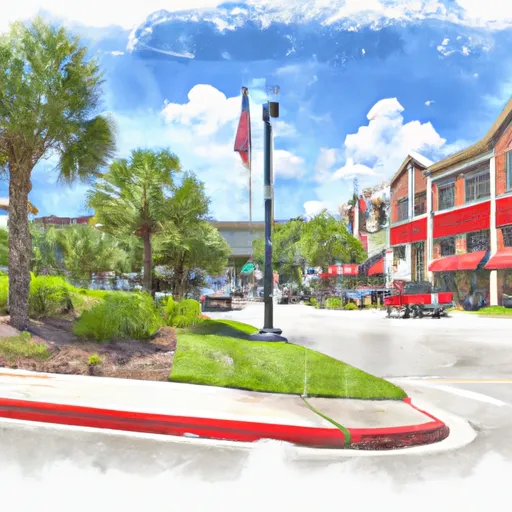-
 Snoflo Premium
Snoflo Premium
Get unlimited access to all our content
With no Ad interruptions! - Start Your Free Trial Login with existing account
Lynn-Haven
Eden Index
Climate
7.0
•
Recreation
4.4
•
Community
3.0
•
Safeguard
5.1/10

Lynn Haven is a small city located in Bay County, Florida, known for its beautiful natural surroundings and outdoor recreation opportunities. The city enjoys a humid subtropical climate, characterized by hot and humid summers and mild winters. Summers often see temperatures reaching the 90s (Fahrenheit), while winters are usually mild with temperatures ranging from the 50s to 60s.
Lynn Haven is surrounded by numerous bodies of water, including the Gulf of Mexico, North Bay, and the Lynn Haven Bayou. These hydrology constituents provide ample opportunities for outdoor activities such as boating, fishing, kayaking, and swimming. The area is also home to several parks and nature trails, allowing visitors to explore the region's diverse flora and fauna.
Outdoor enthusiasts can enjoy the pristine beaches of nearby Panama City Beach, which offers activities like snorkeling, jet skiing, and parasailing. St. Andrews State Park is another popular destination that offers hiking trails, camping sites, and opportunities for birdwatching and wildlife viewing.
Overall, Lynn Haven's climate, hydrology constituents, and outdoor recreation opportunities make it an ideal destination for those seeking to experience the natural beauty and adventure that Florida has to offer.
What is the Eden Index?
The Snoflo Eden Index serves as a comprehensive rating system for regions, evaluating their desirability through a holistic assessment of climate health, outdoor recreation opportunities, and natural disaster risk, acknowledging the profound impact of these factors on livability and well-being.
Climate Health Indicator (CHI): 7.0
Lynn-Haven receives approximately
1644mm of rain per year,
with humidity levels near 89%
and air temperatures averaging around
20°C.
Lynn-Haven has a plant hardyness factor of
9, meaning
plants and agriculture in this region tend to thrive here all year round.
By considering the ideal temperature range, reliable water supplies, clean air, and stable seasonal rain or snowpacks, the Climate Health Indicator (CHI) underscores the significance of a healthy climate as the foundation for quality living.
A healthy climate is paramount for ensuring a high quality of life and livability in a region, fostering both physical well-being and environmental harmony. This can be characterized by ideal temperatures, reliable access to water supplies, clean air, and consistent seasonal rain or snowpacks.
Weather Forecast
Streamflow Conditions
Florida Panhandle Coastal
Area Rivers
Florida Panhandle Coastal
Snowpack Depths
Florida Panhandle Coastal
Reservoir Storage Capacity
Florida Panhandle Coastal
Groundwater Levels
Recreational Opportunity Index (ROI): 4.4
The Recreational Opportunity Index (ROI) recognizes the value of outdoor recreational options, such as parks, hiking trails, camping sites, and fishing spots, while acknowledging that climate plays a pivotal role in ensuring the comfort and consistency of these experiences.
Access to outdoor recreational opportunities, encompassing activities such as parks, hiking, camping, and fishing, is crucial for overall well-being, and the climate plays a pivotal role in enabling and enhancing these experiences, ensuring that individuals can engage in nature-based activities comfortably and consistently.
Camping Areas
| Campground | Campsites | Reservations | Toilets | Showers | Elevation |
|---|---|---|---|---|---|
| Panama City CSS Military | None | 6 ft | |||
| St. Andrews State Park | None | 10 ft | |||
| Engineer Beach RV Military - Fort Rucker | None | 225 ft | |||
| Blue Springs State Park | 50 | 306 ft | |||
| Chewacla State Park | None | 516 ft | |||
| Falling Waters State Park | None | 267 ft | |||
| Lake Martin Military | None | 514 ft | |||
| Raptor Ranch - Tyndall AFB Military | None | 12 ft |
Nearby Ski Areas
Catastrophe Safeguard Index (CSI):
The Catastrophe Safeguard Index (CSI) recognizes that natural disaster risk, encompassing floods, fires, hurricanes, and tornadoes, can drastically affect safety and the overall appeal of an area.
The level of natural disaster risk in a region significantly affects safety and the overall livability, with climate change amplifying these risks by potentially increasing the frequency and intensity of events like floods, fires, hurricanes, and tornadoes, thereby posing substantial challenges to community resilience and well-being.
Community Resilience Indicator (CRI): 3.0
The Community Resilience Indicator (CRI) recognizes that education, healthcare, and socioeconomics are crucial to the well-being of a region. The CRI acknowledges the profound impact of these elements on residents' overall quality of life. By evaluating educational resources, healthcare accessibility, and economic inclusivity, the index captures the essential aspects that contribute to a thriving community, fostering resident satisfaction, equity, and social cohesion.

